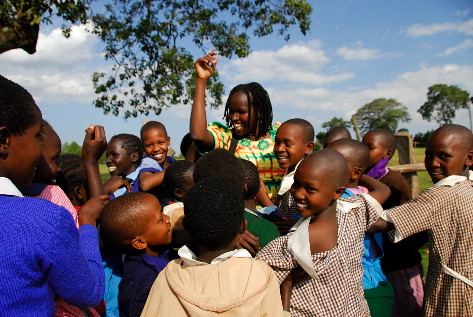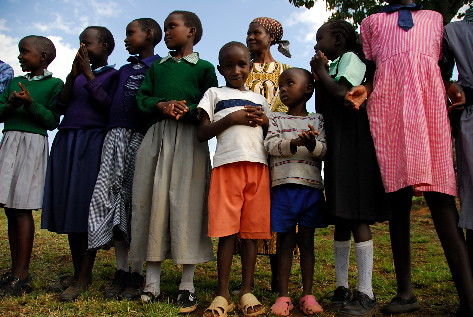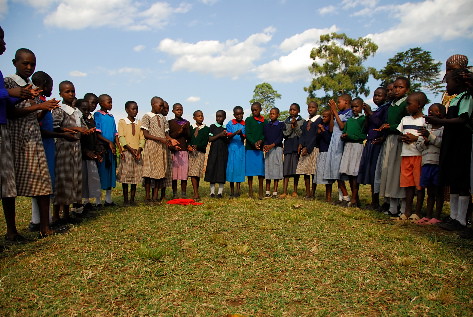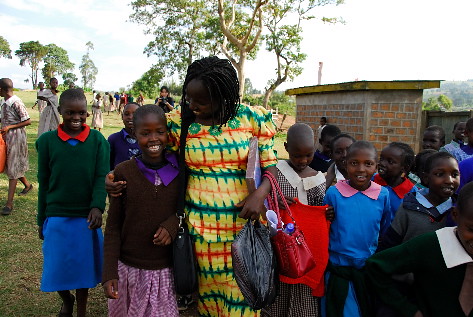“All I want to do is see my girls. Are we going to make it? Oh look, it’s already past four.” Kakenya is pointing from the window of the car at the school children, running in their uniforms along the roadside. School has just let out and children are chasing skipping darting everywhere, unattended, on their long walks back home. We pull into Kakenya’s hometown of Enoosaen and quickly leave the rows of shops for a dirt road leading into the hills. The car lets us out and Kakenya is walking fast, her excitement building as we see the sign, “Kakenya’s Center for Excellence.” And just as we have the driveway in our sights, a flood of girls comes around the fenced corner. There are so many of them, their dresses different colors and patterns – some bright pink, others brown-and-white checks, a few with green collars peeping out from torn sweaters. Their small bodies stretch over the earth like track sprinters, hugging the twists in the path as they close in on us. From only a few feet away, their smiles are wild – huge and full of joyful screaming; Kakenya is waiting, her arms open, and all of the delicate frames in bright colors come rushing into her, hugging one another when they cannot reach Kakenya. I became, in a matter of seconds, completely devoted to these girls. Their goodness was so clear, whole; the world should belong to them.
 Photo: Kate Cummings. Location: Enoosaen, Kenya. Partner: Vital Voices
Photo: Kate Cummings. Location: Enoosaen, Kenya. Partner: Vital Voices
It takes actually very little information to know someone. It takes only, for example, the abandon in the girls’ sprint to know them. It takes just the size and grip of the embrace that surrounded Kakenya to know Kakenya’s Center for Excellence. And it took only one moment of looking at Kakenya, surrounded by the uncontained love of her students, to know that Kakenya is exactly the person you have always hoped for.
 Photo: Kate Cummings. Location: Enoosaen, Kenya. Partner: Vital Voices
Photo: Kate Cummings. Location: Enoosaen, Kenya. Partner: Vital Voices
The Center was officially begun the groundbreaking ceremony last summer, and thirty-one girls started filling the classroom a year later in May, 2009. The school is unique in many ways – offering the first primary boarding school in the district, leadership training that empowers the girls to speak and present themselves with confidence, and Kakenya hopes that soon there will be summer leadership camps that open up the opportunities of the school’s leadership training to other girls in the region who are not boarders. Kakenya also wants to plant corn and other vegetables on school property so the students can have their own supply of food (and training in agricultural practices).
The girls at the Center are between eight and fourteen, and many of them are among the most underprivileged girls in Transmara district. Many of them are at risk of early marriage, female genital mutilation, and a life governed by poverty (like many of their parents). Presently, the school is still under construction, and the girls are going to class in a nearby building made of aluminum sheeting. The dormitories have not yet been built, but the district’s Member of Parliament has contributed the funds for its construction. Many of the girls walk over two hours to school each day, alone, on isolated roads in the hills. It goes without saying that the completion of the dormitories will make the lives of the girls immeasurably more safe and stable.
 Photo: Kate Cummings. Location: Enoosaen, Kenya. Partner: Vital Voices
Photo: Kate Cummings. Location: Enoosaen, Kenya. Partner: Vital Voices
The girls seem unaffected by their temporary learning center, but Kakenya is pained to see the two-story school incomplete and her students without the amenities she anticipated. “You see their outfits? All of the holes in the dresses and the sweaters? We have got to get their uniforms before I leave!” We are at an assembly in the open field with the scaffolded school building. The girls are singing songs of welcome, answering Kakenya’s questions in unison “Are you studying hard?” “Yes!” “Are you treating each other like sisters?” “Yes!” The two teachers, Madame Lydia and Madame Margaret, stand proudly behind their pupils, encouraging some girls to speak up and others to straighten their bodies instead of slumping away in shyness. There is nothing sleepy or sedentary about these children, which is more than I can say from my days working in America’s public school system. They are poised for instruction, eager to be – of all things – polite; for this American, the brightness of these attentive faces is the most miraculous outcome of Kakenya’s Center.
 Photo: Kate Cummings. Location: Enoosaen, Kenya. Partner: Vital Voices
Photo: Kate Cummings. Location: Enoosaen, Kenya. Partner: Vital Voices
And, unlike Kakenya, these girls have a role model for another kind of future – Kakenya herself. “If I had a woman to look up to when I was a girl,” Kakenya says, “I wouldn’t have had to struggle so much by myself.” Kakenya is an ideal model: tall and graceful, respectful of her community elders and boldly insistent on adjusting cultural norms that subjugate girls and women. The students affectionately address Kakenya as their mother, and all of them are clearly her children. “Look at my girls,” Kakenya leans over and whispers. “Aren’t they perfect?” And if only you were here to see, you would agree: they are, unequivocally, perfect.
 Photo: Kate Cummings. Location: Enoosaen, Kenya. Partner: Vital Voices
Photo: Kate Cummings. Location: Enoosaen, Kenya. Partner: Vital Voices
Postscript: I am writing to you from the nurses station at Enoosaen’s maternity ward. This is one of the only places in town where electricity, when you’re lucky, is available. When I come out of the room periodically and look across the hall, there is often a woman who is just about to, is in the process of, or has just gone through having a baby. Today when I come out, I see a young girl on the table. There is only a thin sheet for a doorway, and I catch a glimpse of her face laying sideways on the torn mat of the table. My friend Lillian, the attending clinician, comes out from behind the curtain. “She is just about to give birth.” I nod, still craning my neck around to the open door. “Do you know? She is fourteen and she has already been cut (had female genital mutilation). She is unmarried, so any man that marries her from here will treat her like” and Lillian flicks her hand to the ground, “nothing. Now,” she looks hard at me, and I bring my eyes back from the doorway to meet hers. “her education is over.” She invites me to watch the birth, and I quickly refuse. As I am typing this to you, the cries of the newborn are audible through the door. Another girl’s future has been decided.
Posted By Kate Cummings
Posted Aug 4th, 2009

